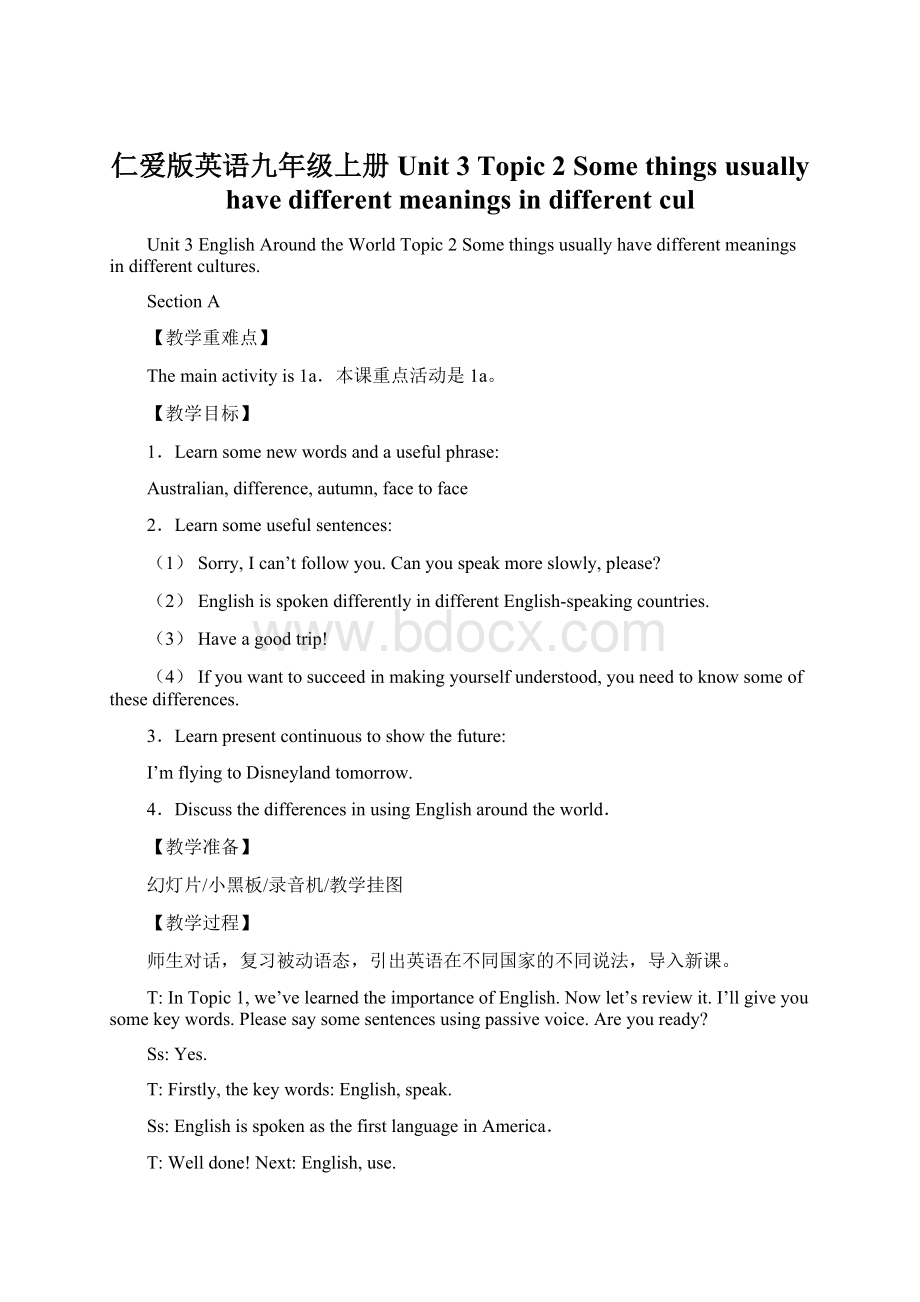仁爱版英语九年级上册Unit 3 Topic 2 Some things usually have different meanings in different cul.docx
《仁爱版英语九年级上册Unit 3 Topic 2 Some things usually have different meanings in different cul.docx》由会员分享,可在线阅读,更多相关《仁爱版英语九年级上册Unit 3 Topic 2 Some things usually have different meanings in different cul.docx(24页珍藏版)》请在冰豆网上搜索。

仁爱版英语九年级上册Unit3Topic2Somethingsusuallyhavedifferentmeaningsindifferentcul
Unit3EnglishAroundtheWorldTopic2Somethingsusuallyhavedifferentmeaningsindifferentcultures.
SectionA
【教学重难点】
Themainactivityis1a.本课重点活动是1a。
【教学目标】
1.Learnsomenewwordsandausefulphrase:
Australian,difference,autumn,facetoface
2.Learnsomeusefulsentences:
(1)Sorry,Ican’tfollowyou.Canyouspeakmoreslowly,please?
(2)EnglishisspokendifferentlyindifferentEnglish-speakingcountries.
(3)Haveagoodtrip!
(4)Ifyouwanttosucceedinmakingyourselfunderstood,youneedtoknowsomeofthesedifferences.
3.Learnpresentcontinuoustoshowthefuture:
I’mflyingtoDisneylandtomorrow.
4.DiscussthedifferencesinusingEnglisharoundtheworld.
【教学准备】
幻灯片/小黑板/录音机/教学挂图
【教学过程】
师生对话,复习被动语态,引出英语在不同国家的不同说法,导入新课。
T:
InTopic1,we’velearnedtheimportanceofEnglish.Nowlet’sreviewit.I’llgiveyousomekeywords.Pleasesaysomesentencesusingpassivevoice.Areyouready?
Ss:
Yes.
T:
Firstly,thekeywords:
English,speak.
Ss:
EnglishisspokenasthefirstlanguageinAmerica.
T:
Welldone!
Next:
English,use.
Ss:
Englishiswidelyusedthroughouttheworld.
…
T:
Goodonya,mate!
Canyouunderstandme?
Ss:
Sorry,wecan’t.
T:
Ijustsaid“Welldone!
”InAustralia,peopleusethewords“Goodonya,mate!
”insteadof“Welldone!
”
(板书)
Goodonya,mate!
=Welldone!
T:
Infact,thoughEnglishiswidelyspokenaroundtheworld,therearesomedifferencesamongAmericanEnglish,BritishEnglish,CanadianEnglishandAustralianEnglish.Whatarethedifferencesbetweenthem?
Let’scometo1aandlearnaboutit.
(板书并要求学生掌握difference和Australian;理解British。
)
different—difference
British
Australian
Step2Presentation
布置听力任务,以听的形式呈现1a内容,然后指导学生进行小组合作,解决1a中的重难点。
1.(用幻灯片呈现听力任务,听录音二遍后,核对答案。
)
(1)Howtosay“hello”inAustralia?
(2)InAustralia,whatdopeoplecallalltheirfriends?
(3)Whocallgirls“sheilas”,CanadiansorAustralians?
T:
Englishisspokendifferentlyindifferentcountries.Nowpleaselistentothetapecarefullyandanswerthequestionsabove.
2.(教师用小黑板或幻灯片呈现下列内容,学生阅读1a,根据不同国家的语言表达习惯,完成表格,并理解生词trunk。
)
g’dayhellofriendsmatesGoodonya,mate!
WelldoneSheilasheilasboottrunk
(板书并解释生词。
)
trunk
BritishEnglish
AustralianEnglish
CanadianEnglish
AmericanEnglish
T:
Stopreading,please.NowwhocantellmewhichexpressionsareBritishEnglish?
Pleaseputupyourhands.S1.
S1…
T:
WhichexpressionsareAustralianEnglish?
S2…
3.(要求学生再读1a,指导学生进行小组合作,找出重难点并讨论解决。
)
(板书并要求学生理解。
)
suitcase
Step3Consolidation
通过听录音、师生对话和复述,让学生巩固所学知识,并培养其实际运用语言的能力。
1.(教师讲解语法:
现在进行时表示将来。
听录音并跟读,注意语音语调,巩固1a。
)
(板书下列内容。
)
Grammar:
Showingthefuturebypresentcontinuous.
e.g.①I’mcoming.
②I’mleaving.
③I’mflyingtoDisneylandtomorrow.
…
(让学生初步掌握该语法。
)
2.(出示1b中的四幅图片,师生问答,复习1a中的内容,完成1b。
)
T:
Boysandgirls,pleaselookatPicture1.What’retheboysdoing?
Ss:
Theyaregreetingwhentheymeetonthewaytoschool.
T:
Doyouknowwhattheyaresaying?
Ss:
G’day.
T:
IftheycomefromGreatBritain,whatwilltheysay?
Ss:
Theywillsay“Hello/Hi,nicetomeetyou…”
T:
You’reright.
(以同样的方式呈现其他三幅图片,师生进行对练,或者让学生同桌对练。
)
3.(在前面操练的基础上,复述课文,可采取分组活动的方式进行,然后选出几名学生做简短演讲。
)
S1:
Ladiesandgentlemen,I’mveryhappytospeakhere.Mytopicis“DifferentCountries,DifferentEnglish”…
4.(让学生完成1c,并核对答案。
)
T:
Pleasefinish1cbyyourself,thenwewillchecktheanswers.
Step4Practice
通过做游戏的形式谈论不同国家在英语表达上的差异。
做听力练习,讨论e-mailEnglish,让书本知识走进学生的生活,培养学生的综合语言运用能力。
1.(玩游戏的过程中,要求每两个学生把同一意思的两种英语表达对应起来进行对练。
)
T:
Let’splayagameandexpressthesamemeaningwiththesedifferentwordsorsentences.Onestudentsaysasentenceandthepartnersaysanotherexpressionthathasthesamemeaning.Doyouunderstand?
Ss:
Yes.
T:
S1,S2,pleasedoitfirst.
S1:
Iwillsay“Hello”toyouwhenwemeetinEngland.
S2:
Iwillsay“G’day”toyouifwearefromAustralia.
…
2.(做听力练习,完成2。
)
T:
Goodonya,mate!
We’velearnedtoexpressthesamemeaningwithdifferentwords.Nowpleaselistento2andfindoutwhat“fall”meansinthisdialog.
(听录音后,核对答案,要求学生掌握生词autumn。
并解释fall在美式英语中的意思。
)
(板书)
autumn=fall
3.(让学生根据3中的内容猜其意思,并给出更多的网络语言。
完成3。
)
T:
WeknowEnglishisveryinteresting.Ithasdifferentmeaningsindifferentcountries.ThereisanotherinterestingEnglish,whichiscallede-mailEnglish.
T:
Boysandgirls,doyoulikesurfingtheInternet?
Ss:
Yes.
T:
Doyouoftensende-mailstoyourfriends?
Ss:
Yes.
T:
OK.Doyouknowthemeaningsofthefollowinge-mailEnglishin3?
Youcanreaditfirstly.
(学生阅读3,1分钟后。
)
T:
Now,let’schecktheanswers.
(板书并要求学生掌握。
)
facetoface
T:
Canyougivemoreexamplesofe-mailEnglish?
Ss:
Yes.
(一个学生说,其他同学猜意思)
S1…
S2:
Itmeans…
Step5Project
分组展示,组内交流,评价与鼓励。
培养学生综合运用能力和探究能力,体现学以致用原则。
1.(小组活动。
把学生分成几组,分别写出由汉语转化而来的英文单词及由英语转化而来的汉语外来词。
评选出优胜小组。
)
Forexample:
EnglishwordfromChinese
Kungfu,tofu…
ChinesewordfromEnglish
咖啡,可口可乐……
2.Homework:
Collectmoreinformationaboute-mailEnglish.
【板书设计】
Englishisspokendifferentlyindifferentcountries.
SectionA
different→differenceSorry,Ican’tfollowyou.Canyouspeakmoreslowly,please?
facetofaceI’mflyingtoDisneylandtomorrow.
Haveagoodtrip!
SectionB
【教学重难点】
Themainactivityis1a.本课重点活动是1a。
【教学目标】
1.Learnanewwordandsomephrases:
see…off,putout,askforaride,getin,pickup,victory
2.Learnsomeusefulsentences:
(1)Theforeignerisaskingforaride.
(2)It’squiteallright.
(3)IhopeIwon’thavemuchdifficultycommunicating.
(4)Wheneveryouneedhelp,sendmeane-mailorcallme.
3.Goonlearningpresentcontinuoustoshowthefuture:
(1)Myuncleismeetingustomorrow.
(2)WhenareyouleavingforDisneyland?
(3)I’mleavingthisafternoon.
【教学准备】
录音机/幻灯片/教学挂图/小卡片
【教学过程】
Step1Review
通过师生对话,复习不同英语国家的表达习惯及网络用语,引出手势语,导入1a。
T:
WeknowthatEnglishisspokendifferentlyindifferentcountries.ThenhowtosayhellotoeachotherinAustralia?
S1:
Theysay“g’day”.
T:
Whatdoestheword“boot”meaninBritishEnglish?
S2:
It’sthetrunkofacar.
T:
Good!
What’sthemeaningof“F2F”ine-mailEnglish?
S3:
Facetoface.
T:
Whatabout“GR8”?
S4:
Itmeans“great”.
T:
Welldone!
Infact,Englishspeakerscommunicateinthiskindofsimplifiedform.Besides,theyalsousegesturestoexpresstheirmeanings.Lookatme.Thisismythumb.Iputoutmyhandwithmythumbraised.(做拇指朝上伸出手的动作。
)What’smymeaning?
Doyouknow?
Ss:
Sorry,wedon’tknow.
T:
ItmeansthatIamaskingforaride.
(板书生词及短语,讲解并要求掌握putout,askforaride;了解thumb。
)
thumb
putout
askforaride
T:
OK,lookatthepicturein1a,what’stheforeignerdoing?
Ss:
Heisaskingforaride.
T:
Yes,whereishegoing?
Let’slistento1a.
Step2Presentation
让学生带着问题听1a的录音,以听力的形式呈现1a内容,并找出文中重点词句和目标语言,师生共同学习语法,为下一步的学以致用打基础。
1.(设置听力任务,首先帮助学习理解生词flight,然后让学生带着任务听1a录音,从整体上把握对话意思,并完成所列问题。
)
(板书要求学生理解。
)
flight
T:
Listentothetapeandanswerthefollowingquestions.
(1)What’stheforeignerleavingfor?
(2)WhenisWangJunfeng’sflight?
(师生一起核对答案,对错误答案先不纠正,让学生再听一遍,找出问题的关键进行对比,提高学生听力技能。
)
2.(让学生朗读1a,在练习本中写下现在进行时表示将来的句子,仔细观察并试着去掌握。
)
T:
Pleaseread1aandwritedownthesentencesthatusepresentcontinuoustoshowthefuture.
(板书)
I’mflyingtoDisneyland.
I’mleavingthisafternoon.
Myuncleismeetingustomorrow.
3.(师生共同总结现在进行时表将来的用法,教师用幻灯片展示。
)
现在进行时表将来时常有“意图”、“安排”(但不是固定不变的)或“打算”的含义,这种现在进行时比较生动,给人一种期待感。
它常表示最近或较近的将来,所用动词多是位移动词(come,go,start,leave,stay,arrive…)。
例如:
I’mgoing.
Whenareyoustarting?
I’mleavingtomorrow.
…
表示将来的现在进行时除用位移动词外,亦可用某些非位移动词。
例如:
I’mmeetingyouafterclass.
Sheisbuyinganewbikesoon.
…
4.(小组合作,找出1a的重点词组,同时教师帮助学生掌握see…off和getin;理解minibus;了解guidebook。
)
(板书生词并解释。
)
see…off,getin,minibus,guidebook
(幻灯片展示下列词句。
)
Theyareontheirwaytotheairport.→onone’swayto
MichaelandKangkangaregoingtoseethemoff.→seesb.off
IhopeIwon’thavemuchdifficultycommunicating.→havedifficulty(in)doing…
Step3Consolidation
以角色表演等形式巩固1a,并操练现在进行时表将来的用法,体现学以致用原则,培养学生语言实际运用能力。
1.(播放1a录音,学生跟读并注意语音语调,然后进行人机对话。
)
T:
Readafterthetapeandpayattentiontothepronunciationandintonation.SupposeyouareWangJunfeng.Listentothetapeandmakeadialogwithit.
2.(学生分组对话练习,然后让每组分角色进行表演。
完成1a。
)
T:
Class,nowlet’sworkingroups.I’llchoosesixstudentstoactthedialogoutinthefront.
3.(根据1a,判断正误,完成1b。
)
T:
MarkTrueorFalseaccordingto1a.Finish1b.
(核对答案。
教师解释pickup并板书。
要求学生掌握该词组。
)
pickup
4.(教师展示1c图画,给出一些关键词,让学生用现在进行时表将来的结构造句并板书。
)
T:
Herearesomepictures.Nowmakesentenceswiththekeywordsgivenbelow,usingpresentcontinuoustoshowthefuture.
leaveforDisneylandthisafternoontraveltoCanadatomorrow
comehomeintwentyminutesstartat7o’clockgotoShanghainextweek
Picture1:
…isleavingforDisneylandthisafternoon.
Picture2:
…istravelingtoCanadatomorrow.
Picture3:
…isgettinghomeintwentyminutes.
Picture4:
…isstartingat7o’clock.
Picture5:
…isgoingtoShanghainextweek.
5.(在熟悉现在进行时表将来的用法之后,两人一组对话操练,完成1c。
)
T:
Pairwork.Makedialogswithyourpartneraccordingtotheexamplein1c.
Example:
A:
WhenareyouleavingforDisneyland?
B:
I’mleavingthisafternoon.
(在每个小组充分训练之后,教师找出几组表演对话。
)
T:
NowI’llaskseveralgroupstoactoutthedialogs.Let’shaveacompetition.
(通过竞赛,让学生熟练掌握现在进行时表将来的用法。
)
Step4Practice
学习体态语,巩固现在进行时表将来的用法。
在不同情境中练习目标语言,展开任务型活动,激发学生学习兴趣。
1.(准备一些写有指令性动作的卡片,如goshopping,leaveforShanghai,flytoAmerica等等,让一些同学来抽,抽到哪个指令就做一些相关动作,让其他同学猜,进行组与组间的评比。
)
T:
Ihavesomecardshere.Therearesomeinstructionsonthem.I’llaskonestudenttochooseacardandheshoulddoanactionaccordingtothecardhegets.Otherstudents